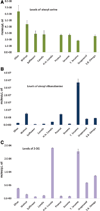Levels of bioactive lipids in cooking oils: olive oil is the richest source of oleoyl serine
- PMID: 26565552
- PMCID: PMC4959147
- DOI: 10.1515/jbcpp-2015-0104
Levels of bioactive lipids in cooking oils: olive oil is the richest source of oleoyl serine
Abstract
Background: Rates of osteoporosis are significantly lower in regions of the world where olive oil consumption is a dietary cornerstone. Olive oil may represent a source of oleoyl serine (OS), which showed efficacy in animal models of osteoporosis. Here, we tested the hypothesis that OS as well as structurally analogous N-acyl amide and 2-acyl glycerol lipids are present in the following cooking oils: olive, walnut, canola, high heat canola, peanut, safflower, sesame, toasted sesame, grape seed, and smart balance omega.
Methods: Methanolic lipid extracts from each of the cooking oils were partially purified on C-18 solid-phase extraction columns. Extracts were analyzed with high-performance liquid chromatography-tandem mass spectrometry, and 33 lipids were measured in each sample, including OS and bioactive analogs.
Results: Of the oils screened here, walnut oil had the highest number of lipids detected (22/33). Olive oil had the second highest number of lipids detected (20/33), whereas grape-seed and high-heat canola oil were tied for lowest number of detected lipids (6/33). OS was detected in 8 of the 10 oils tested and the levels were highest in olive oil, suggesting that there is something about the olive plant that enriches this lipid.
Conclusions: Cooking oils contain varying levels of bioactive lipids from the N-acyl amide and 2-acyl glycerol families. Olive oil is a dietary source of OS, which may contribute to lowered prevalence of osteoporosis in countries with high consumption of this oil.
Figures

Similar articles
-
Effect of a 6-month intervention with cooking oils containing a high concentration of monounsaturated fatty acids (olive and canola oils) compared with control oil in male Asian Indians with nonalcoholic fatty liver disease.Diabetes Technol Ther. 2014 Apr;16(4):255-61. doi: 10.1089/dia.2013.0178. Diabetes Technol Ther. 2014. PMID: 24625239 Clinical Trial.
-
Discrimination and classification of extra virgin olive oil using a chemometric approach based on TMS-4,4'-desmetylsterols GC(FID) fingerprints of edible vegetable oils.Food Chem. 2019 Feb 15;274:518-525. doi: 10.1016/j.foodchem.2018.08.128. Epub 2018 Sep 5. Food Chem. 2019. PMID: 30372973
-
Discriminating olive and non-olive oils using HPLC-CAD and chemometrics.Anal Bioanal Chem. 2011 Feb;399(6):2083-92. doi: 10.1007/s00216-010-4366-4. Anal Bioanal Chem. 2011. PMID: 21060998
-
Membrane composition and dynamics: a target of bioactive virgin olive oil constituents.Biochim Biophys Acta. 2014 Jun;1838(6):1638-56. doi: 10.1016/j.bbamem.2014.01.007. Epub 2014 Jan 16. Biochim Biophys Acta. 2014. PMID: 24440426 Review.
-
The effect of olive oil on osteoporosis prevention.Int J Food Sci Nutr. 2014 Nov;65(7):834-40. doi: 10.3109/09637486.2014.931361. Epub 2014 Jun 30. Int J Food Sci Nutr. 2014. PMID: 24975408 Review.
Cited by
-
(Wh)olistic (E)ndocannabinoidome-Microbiome-Axis Modulation through (N)utrition (WHEN) to Curb Obesity and Related Disorders.Lipids Health Dis. 2022 Jan 14;21(1):9. doi: 10.1186/s12944-021-01609-3. Lipids Health Dis. 2022. PMID: 35027074 Free PMC article. Review.
-
Qualitative and Quantitative Analysis of Six Fatty Acid Amides in 11 Edible Vegetable Oils Using Liquid Chromatography-Mass Spectrometry.Front Nutr. 2022 Mar 28;9:857858. doi: 10.3389/fnut.2022.857858. eCollection 2022. Front Nutr. 2022. PMID: 35419400 Free PMC article.
-
HU-671, a Novel Oleoyl Serine Derivative, Exhibits Enhanced Efficacy in Reversing Ovariectomy-Induced Osteoporosis and Bone Marrow Adiposity.Molecules. 2019 Oct 16;24(20):3719. doi: 10.3390/molecules24203719. Molecules. 2019. PMID: 31623098 Free PMC article.
References
-
- Johnell O, Kanis JA. An estimate of the worldwide prevalence and disability associated with osteoporotic fractures. Osteoporos Int. 2006;17:1726–1733. - PubMed
-
- Kanis J on behalf of the WHO Scientific Group. Technical report. University of Sheffield, UK: WHO Collaborating Centre for Metabolic Bone Diseases; 2007. Assessment of osteoporosis at the primary health care level; p. 66.
-
- Fistonic I, Situm M, Bulat V, Harapin M, Fistonic N, Verbanac D. Olive oil biophenols and women’s health. Med Glas (Zenica) 2012;9:1–9. - PubMed
-
- Garcia-Martinez O, Rivas A, Ramos-Torrecillas J, De Luna-Bertos E, Ruiz C. The effect of olive oil on osteoporosis prevention. Int J Food Sci Nutr. 2014;65:834–840. - PubMed
MeSH terms
Substances
Grants and funding
LinkOut - more resources
Full Text Sources
Other Literature Sources
